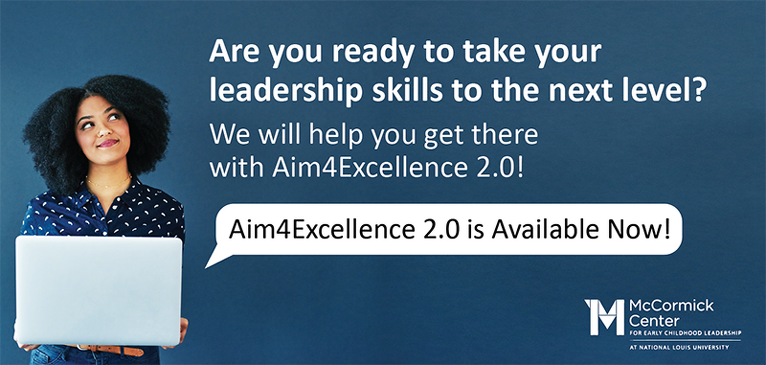
At the McCormick Center for Early Childhood Leadership, we know that leadership matters
. Enhanced leadership competencies and increased leadership capacity within the early childhood workforce yield sustainable improvements in program quality, which will in turn improve outcomes for the children and families that our field serves. We support early childhood education leaders in a number of ways to enhance competencies and grow capacity, but at no time in our history has Aim4Excellence – our fully online National Director Credential – been so vital to our field.
– our fully online National Director Credential – been so vital to our field.
What is Aim4Excellence?
Our Aim4Excellence National Director Credential focuses on the essential competencies needed to deliver high-quality programming for young children and their families. Aim4Excellence empowers program and site leaders to be change agents, ready to support the ongoing development of children, families, and staff. Aim4Excellence builds administrative competence in center operations, talent development, financial management, strategic planning, family engagement, support of teaching and learning, and using data for continuous quality improvement. The content is specific to the responsibilities of early childhood program and site leaders and is designed around their unique needs as adult learners.
Aim4Excellence was first introduced more than a decade ago – long before distance learning was common practice. At that time, early childhood administrators had varying levels of technology skills and Internet connectivity was spotty. However, there was a significant need for high-quality, accessible, and affordable leadership development. In 2008, Barbara Willer, who was then a director of the National Association for the Education of Young Children (NAEYC), asked the McCormick Center if we had the capacity to develop a fully online administrator credential to meet the needs of program and site leaders across the nation. The McCormick Center answered this call. To date, more than 2,000 early childhood educators have earned their Aim4Excellence National Director Credential.
Administrators today are much more tech-savvy and high-speed internet access is becoming the norm. Since its launch, Aim4Excellence has been updated several times, but with Aim4Excellence 2.0, it has been completely revamped. Aim4Excellence 2.0 now provides a state-of-the-art distance learning experience while maintaining its steadfast commitment to quality content and easy access at an excellent value.
What’s new in Aim4Excellence 2.0?
Aim4Excellence 2.0 is competency-based and aligned to the McCormick Center’s Whole Leadership Framework . Whole Leadership is the inter-dependent relationship that exists between three leadership domains: Administrative Leadership, Pedagogical Leadership, and Leadership Essentials ( View the resource Aim4Excellence National Director Credential – The Whole Leadership Approach to Online Leadership Development for the Whole Leadership Framework and its alignment to all nine Aim4Excellence 2.0 modules ). Now participants have more choice. They may complete all nine modules and earn the Aim4Excellence National Director Credential, or they may choose to focus on strengthening their competencies in one domain of Whole Leadership based on their interests or scopes of work.
The new Aim4Excellence 2.0 is designed using best practices for engagement and interaction. Throughout the nine modules, content is provided in a variety of interactive mediums and provides authentic and applicable scenarios. Information throughout each module builds on previous sections, scaffolding the learner to increased engagement, retention, and content application.
What’s included in the modules?
Aim4Excellence 2.0 includes nine self-paced modules and all of the learning materials needed to complete the modules. Each module embeds multiple assessments of learning to demonstrate mastery of competencies. Participants may choose to take all nine modules to earn the Aim4Excellence National Director Credential, take only one module to achieve competence in a specific area, or take several modules to build competence in one of the three Whole Leadership domains. Modules may be taken for college credit or for clock-hour credit. NAEYC recognizes Aim4Excellence as an alternative pathway for meeting Administrator qualifications for NAEYC Program Accreditation.
Connect to Aim4Excellence anytime from anywhere with Internet access. Learn at your own pace through an easy online delivery model simple enough for a first-time distance learner. Register and get started!
Have questions? Contact Lorena Rodriguez, Aim4Excellence Manager, at 847.947.5054 or lorena.rodriguez@nl.edu.






